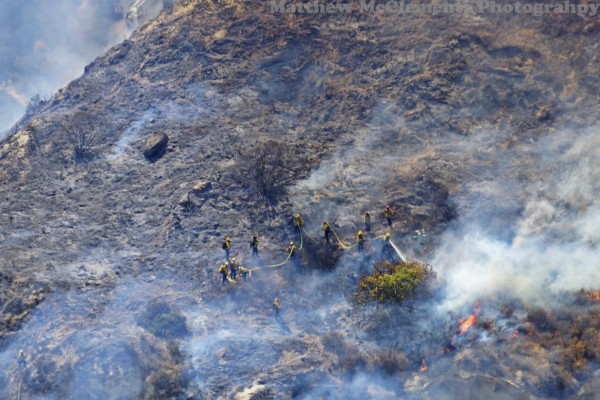
After witnessing a brush fire in Laguna Canyon caused by a tree falling and damaging Southern California Edison power lines, Mayor Bob Whalen called Tuesday for an all-out effort to underground utilities citywide.
“We can no longer risk the public safety of Laguna Beach by allowing above ground utilities,” Whalen said in a statement. “We dodged a bullet last Friday thanks to favorable wind conditions and the extraordinary efforts of the Laguna Beach Fire Department and Orange County Fire Authority, but we can’t continue to roll the dice. A major fire disaster caused by power lines is only a matter of time.”
Whalen called on Edison to join in the effort and shoulder a substantial portion of the cost. “It is no longer safe for them to operate an above ground utility system here,” he said in a statement, which estimated the citywide cost at $150 million.
Whalen said he will request a meeting with Edison President Pedro Pizarro to begin discussions on a citywide undergrounding plan.
Even so, Edison balked at the $6 million price tag of undergrounding the transmission

lines on a section of Laguna Canyon Road in April. As a result, the project will only eliminate 16 poles, instead of the 34 initially contemplated, underwritten by ratepayer funding.
It remains to be seen whether Whalen will have better luck now with Edison. He predicts the city would need to finance its share of costs with bonds, but also at issue is collaborating with Edison to speed up projects, which typically take three years to approve.
In response to Whalen’s call for action, an Edison spokesman said the company “will work with local governments and agencies when undergrounding projects are initiated and approved.” The spokesman added that “safety and reliability” are a top concern.
In the last eight years, at least four fires have been attributed to above-ground Edison utilities, the city statement says.
An arsonist ignited the city’s worst blaze, the 1993 firestorm during howling Santa Ana winds that damaged or destroyed over 400 homes and is still considered one of the nation’s worst fire disasters.

The fire Friday, July 3, began about 3:30 p.m. and started when falling trees hit a power line on Arroyo Drive, which sparked a fire on a brush covered hillside along Laguna Canyon Road. With light winds and air support called in from Hemet, the fire was knocked down after burning about 15 acres, but fire crews remained in the area through the weekend to douse hot spots and to make sure that the fire didn’t restart. Five aircraft and 150 firefighters were deployed, said fire Chief Jeff LaTendresse. “We were the only fire going on,” he said.
Nearly all of Laguna Beach is considered a high fire hazard risk, as rated by the State of California. Residents, motivated by improving views and lowering fire risk, themselves have footed the bill to bury utility lines in their own neighborhoods in 40 percent of the city, the public works department estimates.
Since 2007, Edison power poles have ignited several small fires in Laguna and been involved in 46 accidents along Laguna Canyon Road, the city statement says.
Councilman Rob Zur Schmiede, who with Whalen was appointed by the City Council to identify ways to accelerate undergrounding of power poles, echoed his support for Whalen’s stand.
“We can no longer wait for overhead utilities to be placed underground neighborhood-by-neighborhood,” Zur Schmiede said. “We have some ideas as to how Edison can partner with us financially and hope they are open to negotiating a fair solution.”
Whalen said city officials will also pursue talks with San Diego Gas & Electric, which serves South Laguna residents.
Whalen’s new directive may breath new life into a local initiative begun two years ago that seems to have foundered, but it remains unclear if utility regulators or the company are receptive.
Prompted by Laguna Beach resident and dedicated undergrounding advocate Arnold Hano, then Council member Steve Dicterow and Council member Toni Iseman pushed for the hiring consultants to assess options for burying utility wires citywide back in July 2013. “It’s big, it’s going to take a long time, it’s going to be very expensive, it’s not easy, but we have to start,” Dicterow said at the time.
Poised to subsequently hire a consultant in March 2014, the City Council changed their tack when Laguna Beach resident Dennis Eastman, a 40-year former Edison executive, offered assurances that by “thinking out of the box” the city could be rid of its utility poles more effectively. He suggested powwows with Edison and lobbying the Public Utilities Commission for rules changes. “People don’t realize that the P.U.C. is there to help solve problems and that they tend to side with end users,” Eastman said at the time.
City officials eschewed hiring a consultant in favor of fleshing out Eastman’s ideas.
Two years later, though, the only movement on getting rid of the city’s overhead wires has been on a plan that was approved back in 2010 to remove the poles from the Big Bend section of Laguna Canyon Road and that is just now coming to fruition.
A 2014 PUC report, A Brief Introduction to Utility Poles, says utilities are required to set aside tariffs for such projects in high traffic roadways or areas of public recreation and scenic interest. The Big Bend project, in fact, makes use of such funds. But preventing fire risk “is not a qualifying criterion for undergrounding,” the guideline states.
What’s more, the commission limits the amount of money available from the ratepayer funds for undergrounding, resulting in waiting lists for such projects. Pacific Gas & Electric, based in San Francisco, for example, undergrounds about 30 miles of wires a year using the allotted funds, and in 2007 had a 40-year wait list, the report says.
A PUC investigation of the 2007 Malibu Canyon fire found fault with Edison for poor pole maintenance, but the $37 million settlement agreement didn’t require undergrounding.
A PUC spokesperson asked to comment about Whalen’s plea to Edison, simply reiterated the commission’s existing policies on safety rules and audits.
Whalen said the city prefers coming to terms with Edison before approaching the PUC or state legislature.





[…] a brush fire triggered by a fallen power line in July fanned fears and threatened significant damage, then Mayor Bob Whalen emphatically called for Southern California Edison to “underground” all […]
I do think all cities in the United States like Laguna Canyon, California should ban above-ground power lines because they are too dangerous (you will die if you touch them), and cause cancer from electromagnetic fields that they do create.
Utility companies like National Grid in the future should be fined (or be held accountable) for using above-ground power lines for harming or killing people if that law ever takes effect in the future, just like for that city in California. Beside that city in California, establishing a law for above-ground power lines, that same law should become a federal law for all cities and towns throughout the United States, including Schenectady, New York (or Scotia, NY) where I am from.
That law will be a good thing because during a thunderstorm, people will not have to worry about losing power (when lightning strikes a telephone pole where power lines are attached), or a car crashes into a telephone pole with power lines on top.
Underground power lines in the future should help save lives.
[…] Laguna Canyon on a peak summer weekend in 2015 that led to widespread gridlock ignited the current campaign to try to fend off future disasters. Legislative efforts and coaxing of utility officials to rid […]